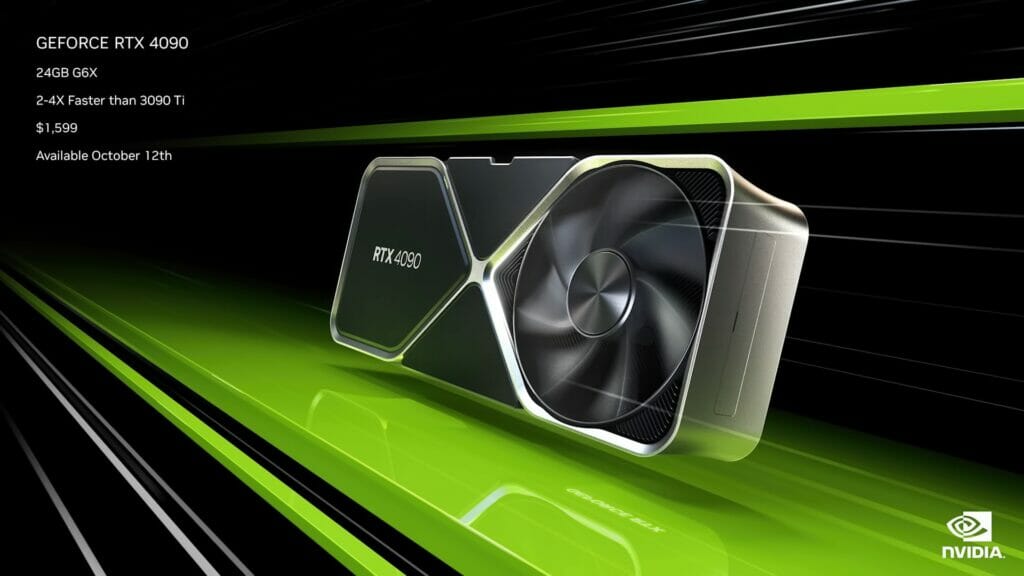
As the rumours were pilling on, and the leaks were getting intense. Nvidia have finally unviedl their latest generation of graphics card. The architecture dubbed Lovelace after Ada Lovelace is is touted to bring a big step up in performance and even more so in Ray Tracing. Let’s dive right in and take a look and what Nvidia will launching this year.
Nvidia RTX 4000 series

The new architecture is built on TSMC 4nprocess and brings the transistor count up to 76 billion. There are lot of new changes under the hood compared to Ampere. The key points include 3rd gen RT cores with 200 RT TFlops of performance. More efficient shader processing with 90 shader TFlops, and lastly 1,400 tensor TFlops with 4th gen Tensor cores. All of this is on top of new DLSS 3.0 that will be exclusive to 40 series cards (more on that later).
The above specs don’t mean much to the actual cards, to which Nvidia will be first launching the RTX 4090, followed by the RTX 4080 12GB and RTX 4080 16GB. Below are the specifications detailed for each card
RTX 40 Series Specifications
| GeForce RTX 4090 | GeForce RTX 4080 (16GB) | GeForce RTX 4080 (12GB) | |
|---|---|---|---|
| NVIDIA CUDA Cores | 16384 | 9728 | 7680 |
| Base/Boost Clock (GHz) | 2.23/2.52 | 2.21/2.51 | 2.31/2.61 |
| Memory Size | 24 GB | 16 GB | 12 GB |
| Memory Type | GDDR6X | GDDR6X | GDDR6X |
| Memory Interface Width | 384-bit | 256-bit | 192-bit |
| Graphics Card Power (W) | 450 | 320 | 285 |
RTX 4090

The RTX is going to be their flagship and it will also be launching first on October 12th. It features 16,384 CUDA Cores, Boost clock up to 2,52GHz, and 24GB of GDDR6X. Pricing is set at $1,599 in the US, but oddly stretches up to €1,949 in Europe and £1,679 in the UK. Pricing for AIB cards is yet to be disclosed, but expected it to be higher for the most part.
Nvidia did not detailed any AIB cards during the announcement. They simply showed off the latest RTX 4090. The design is identical to last generation RTX 30 series. The Founder Edition cards have the same layout and heatsink design. The main change will be the inclusion of the new 12VHPWR for powering the new cards.

The RTX 4080 will launch in two models, and while they look like the same model with different amounts of VRAM, they are in fact very different. The RTX 4080 12GB comes with 7680 CUDA Core and a boost clock of 2.61 ,while the RTX 4080 16GB comes with 9728 CUDA Cores and 2.51 Boost clock. The power limit on the RTX 4080 12GB is also less at 285w vs 320w on the RTX 4080 16GB. The memory bandwidth is also different going from 192=bit the 408012GB up to 256-bit on the 408016GB
It really does seem like a marketing tactic to give these to cards the same ending nomenclature. End users may think ordering the RTX 4080 12GB will get them the same performance as the 16B variant, but that simply won’t be the case. Nvidia could have just easily called the RTX 4080 12GB the RTX 4070/Ti or even RTX 4075 if needs be. None the less, we hope gamers will see through the poor naming convention used by Nvidia here.
The RTX 4080 cards arrive sometime in November, with the RTX 4080 12GB starting at $999 in the US, €1,099 in Europe, and £949 in the UK. The RTX 4080 16GB will start at $1200 in the US, €1,469 in Europe and £1,679 in the UK. Again the pricing on Euro and UK seems rather intense.
DLSS 3

DLSS has become a staple in GPU performance for Nvidia in recent years, with the Super Sampling providing some amazing performance boost for titles that include it. The latest DLSS 3 that was announced alongside Ada Lovelace graphics cards will include yet another bump in performance. So much so that it will take a step further towards rendering entirely new frames and not just pixels. This is done mostly by using the the new optical flow accelerator and game engine motion vectors. These mechanics analysing pixel velocity and direction to generation new frames, along side other AI and rendering mechanics that Nvidia use.
The process partially works by processing new frames along side the previous frame to better understand the changes and predict what should be done. Nvidia’s Jensen Huang even stated because this process generates entirely new frames, it can uplift performance beyond CPU bottlenecks. The performance of DLSS as stated by Jensen is up to 4x compared to brute force rendering.
DLSS 3 on paper sounds like it could be a gamer changer. The only caveat is that this will be exclusive to RTX 40 series cards and will not come to previous generation cards.
Wrap Up
That’s the latest and greatest from Nvidia. Starting with the launch on October 12th for the RTX 4090, followed by the RTX 4080 cards in November. AIB partner cards will likely be launching along side the respective launches for RTX 4090 and RTX 4080. If you wish to check out the full Nvidia GTX broadcast. We include the video below.
